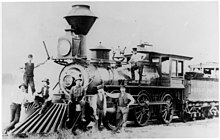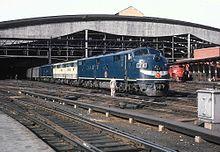Missouri Pacific Railroad
This articleneeds additional citations forverification.(June 2022) |
 | |
 MP system map,c. 1891 | |
| Overview | |
|---|---|
| Headquarters | St. Louis, Missouri |
| Founders | Thomas Allen Wayman Crow John O'Fallon Daniel D. Page |
| Reporting mark | MP |
| Locale | Arkansas,Colorado,Illinois,Kansas,Louisiana,Mississippi,Missouri,Nebraska,Oklahoma,andTexas |
| Dates of operation | 1872–1997 |
| Predecessor | Pacific Railroad |
| Successor | Union Pacific Railroad |
| Technical | |
| Track gauge | 4 ft8+1⁄2in(1,435 mm)standard gauge |

TheMissouri Pacific Railroad(reporting markMP), commonly abbreviated asMoPac,was one of thefirst railroads in the United Stateswest of theMississippi River.MoPac was aClass I railroadgrowing from dozens of predecessors and mergers. In 1967, the railroad operated 9,041 miles of road and 13,318 miles of track, not includingDK&S,NO&LC,T&P,and its subsidiariesC&EIandMissouri-Illinois.
Union Pacific Corporation,the parent company of theUnion Pacific Railroad,agreed to buy the Missouri Pacific Railroad on January 8, 1980. Lawsuits filed by competing railroads delayed approval of the merger until September 13, 1982. After the Supreme Court denied a trial to theSouthern Pacific,the merger took effect on December 22, 1982. However, due to outstanding bonds of the Missouri Pacific, its full merger into the Union Pacific Railroad did not become official until January 1, 1997.
History[edit]
On July 4, 1851, ground was broken at St. Louis on thePacific Railroad,the predecessor of the Missouri Pacific Railroad. The first section of track was completed in 1852; in 1865, it was the first railroad inKansas City,after construction was interrupted by theAmerican Civil War.In 1872, the Pacific Railroad was reorganized as the Missouri Pacific Railway by new investors after a railroad debt crisis. Because of corporate ties extending back to the Pacific Railroad, Missouri Pacific at one time[when?]advertised itself as being "The First Railroad West of the Mississippi".
Other predecessors included theSt. Louis, Iron Mountain and Southern Railway(SLIMS),Texas and Pacific Railway(TP),Chicago and Eastern Illinois Railroad(C&EI),St. Louis, Brownsville and Mexico Railway(SLBM),Kansas, Oklahoma and Gulf Railway(KO&G),Midland Valley Railroad(MV),San Antonio, Uvalde and Gulf Railroad(SAU&G),Gulf Coast Lines(GC),International-Great Northern Railroad(IGN), Kansas, Nebraska & Dakota Railroad,New Orleans, Texas and Mexico Railway(NOTM),Missouri-Illinois Railroad(MI), as well as the smallCentral Branch Railway(an early predecessor of MP in Kansas and south-central Nebraska), and joint ventures such as theAlton and Southern Railroad(AS).
Missouri Pacific was under the control of New York financierJay Gouldfrom 1879 until his death in 1892. Gould developed a system extending throughColorado,Nebraska,Arkansas,Texas,andLouisiana.His sonGeorge Gouldinherited control upon his father's death, but lost control of the company after it declaredbankruptcyin 1915.[1]The line was merged with theSt. Louis, Iron Mountain and Southern Railway(SLIMS) and reorganized as the Missouri Pacific Railroad in 1917. Missouri Pacific later acquired or gained a controlling interest in other lines in Texas, including theGulf Coast Lines,International-Great Northern Railroad,and theTexas and Pacific Railway.
The railroad's first heavy repair shops were built in Sedalia, Missouri in 1872. In 1905 several smaller shop sites were consolidated at Sedalia when the old shops were closed and moved to a new site along Marshall Avenue. The MoPac began using the Baring Cross Shops of theSt. Louis, Iron Mountain and Southern RailwayinNorth Little Rock,Arkansas in 1882. A fire in 1900 caused them to be rebuilt on a larger scale that would ultimately become the primary MoPac shop site (now known as the Downing B. Jenks Shops). Minor locomotive repairs were carried out at the terminals inSt. LouisandKansas City.
MoPac declared bankruptcy again in 1933, during theGreat Depression,and entered intotrusteeship.The company was reorganized and the trusteeship ended in 1956.[1]
By the 1980s, the system owned 11,469 miles (18,458 km) of rail line over 11 states bounded byChicagoto the east,Pueblo, Colorado,in the west, north toOmaha,south to theU.S.-Mexico borderinLaredo, Texas,and southeast along the Gulf seaports ofLouisianaandTexas.MoPac operated a fleet of more than 1,500diesel locomotives,almost all purchased within the previous 10 years. Under the leadership of Downing B. Jenks, who became president and chief executive in 1961, the company became a pioneer in the early days of computer-guided rail technology. It was a major hauler of coal, grain, ore, autos, dry goods andshipping containers.At the time of its mega-merger in 1982, the MoPac owned more and newer locomotives and operated more track than partnerUnion Pacific Railroad.
On December 22, 1982, the Missouri Pacific was purchased by theUnion Pacific Corporationand combined with theWestern Pacific Railroadand Union Pacific Railroad to form one large railroad system. The new entity was called Pacific Rail Systems; though part of the Union Pacific Corporation, all three railroads maintained their own corporate and commercial identity. On December 1, 1989, theMissouri Kansas Texasand theGalveston, Houston & Hendersonwere merged into the Missouri Pacific after having been acquired by the Union Pacific Corporation in 1988.
By 1994, all motive power of the Missouri Pacific was repainted and on January 1, 1997, the Missouri Pacific was officially merged into the Union Pacific Railroad by the Union Pacific Corporation. UP continued to use the MoPac headquarters building at 210 N. 13th St. in downtown St. Louis for its customer service center until February 15, 2005. The former MoPac building has undergone rehab as apartments and is now known as Park Pacific.
| MP | Missouri-Illinois | C&EI | Doniphan Kensett & Searcy | New Orleans & Lower Coast | Asherton & Gulf | San Antonio Southern | Sugar Land Ry | |
|---|---|---|---|---|---|---|---|---|
| 1925 | 11,282 | 84 | 2,355 | 0.2 | 0.8 | 0.8 | 4 | 9 |
| 1933 | 7,457 | 44 | 1,066 | 0.1 | 1.4 | (with MP) | (with MP) | (with MP) |
| 1944 | 25,910 | 188 | 3,456 | 0.1 | 7 | |||
| 1960 | 19,238 | 183 | 2,335 | 0.5 | 9 | |||
| 1970 | 26,907 | 359 | 2,309 | ? | ? |
In this table, "MP" includes New Orleans Texas & Mexico and all its subsidiary railroads (Beaumont Sour Lake & Western, I-GN, StLB&M, etc.) that officially merged into MP in 1956. Ton-miles for C&EI in 1970 presumably don't include the L&N portion.
By that same definition, MP operated 10,431 route-miles at the end of 1929, after A&G, SAS and Sugar Land had come under NOT&M; NO&LC operated 60 and DK&S (not subsidiary until 1931) operated 6. At the end of 1960, MP operated 9,362 route-miles, NO&LC and DK&S were the same, and M-I operated 172 miles.
| T&P | KO&G/KO&G of TX | Midland Valley | Cisco & Northeastern | Pecos Valley Southern | Texas Short Line | |
|---|---|---|---|---|---|---|
| 1925 | 1,763 | 193 | 230 | 4 | 7 | 0.8 |
| 1933 | 1,498 | 163 | 84 | (with T&P) | (with T&P) | (with T&P) |
| 1944 | 4,761 | 412 | 113 | |||
| 1960 | 4,168 | 495 | 97 | |||
| 1970 | 5,854 | 150 (merged Apr 1970) | (merged 1967) |
"T&P" includes its subsidiary roads (A&S, D&PS, T-NM etc.); operated route-miles totaled 2,259 at the end of 1929 (after C≠, PVS and TSL had become subsidiaries) and 2,033 at the end of 1960.
Passenger train service[edit]


In the early years of the 20th century, most Missouri Pacific and St. Louis, Iron Mountain and Southern passenger trains were designated by number only, with little emphasis on premier name trains. This changed in May, 1915, with the inauguration of theScenic Limitedbetween St. Louis, Kansas City, andSan Francisco.BetweenPueblo, ColoradoandSalt Lake City,theScenic Limitedoperated through theRoyal Gorgeover the tracks of theDenver and Rio Grande Railroad.From Salt Lake City toSan Francisco,theScenic Limitedoperated over the Western Pacific Railroad. A second premier train, theSunshine Specialbegan operating on December 5, 1915, between St. Louis andSan AntonioviaLittle RockandAustin.Another named train, theRainbow Special,was placed in service in July 1921 between Kansas City and Little Rock. TheSunshine Specialsoon eclipsed the other trains in travel volume, becoming the signature train of the Missouri Pacific Railroad. An advertising slogan in 1933 proclaimed: "It's 70-degrees in theSunshinewhen it's 100-degrees in the shade,"referring to the fact that theSunshine Specialwas one of the first air-conditioned trains in the southwest. When newstreamlinedtrains were delivered, theScenic LimitedandRainbow Specialnames faded, but theSunshine Specialhad sufficient name recognition to co-exist along with the new streamliners into the late 1950s.
In the streamliner era, the Missouri Pacific's premier passenger trains were collectively known as theEagles.A variety ofEagletrains were operated, with the first such train inaugurated in 1940. These routes included theMissouri River Eagle(St. Louis-Kansas City-Omaha), theDelta Eagle(Memphis, Tennessee-Tallulah, Louisiana), theColorado Eagle(St. Louis-Pueblo-Denver), theTexas Eagle(St. Louis toTexas), and theValley Eagle(Houston-Corpus Christi-Brownsville, Texas).

Other notable MoPac trains operated included:
- theHoustonian(between New Orleans and Houston);
- Missourian(between St. Louis and Kansas City);
- Orleanean(between Houston and New Orleans);
- Ozarker(between St. Louis and Little Rock);
- Pioneer(between Houston and Brownsville);
- Southerner(service from Kansas City and St. Louis to New Orleans, via Little Rock);
- Southern Scenic(between Kansas City and Memphis);
- Sunflower(between St. Louis and Wichita); and
- theTexan(between St. Louis and Fort Worth).[citation needed]
Missouri Pacific gained a reputation for aggressively discontinuing passenger trains after the mid-1960s. When the National Railroad Passenger Corporation (Amtrak) assumed passenger train operations on May 1, 1971, the only Missouri Pacific route included as part of Amtrak's basic system was its main line from St. Louis to Kansas City. This route is now served by Amtrak'sMissouri River Runner(named for the fact that it runs mostly parallel to theMissouri River). On March 13, 1974, Amtrak restored passenger train service over segments of Missouri Pacific-Texas and Pacific's originalTexas Eagleroute between St. Louis, Little Rock, Dallas, Austin, San Antonio, andLaredowith theInter-American.This train was renamed theTexas Eaglein 1981, resurrecting the name of the famous MoPac train. The Amtrak version runs over former MoPac and T&P trackage for much of its route.
Honorary tribute[edit]
On July 30, 2005, UP unveiled a brand newEMD SD70ACelocomotive,Union Pacific 1982,with Missouri Pacific paint and logos, as part of a new heritage program.
References[edit]
- ^abUnion Pacific Railroad."UP: Chronological History."Archived2006-08-10 at theWayback MachineAccessed 2009-12-18.
- Trainweb/Screaming Eagles."About Missouri Pacific: A Brief Overview."Accessed 2009-12-18.
- Goen, Steve Allen (1997).Texas & Pacific Color Pictorial,Four Ways West Publications,La Mirada,CA.ISBN1-885614-17-9
- Stout, Greg (1995).Route of the Eagles, Missouri Pacific in the Streamlined Era,White River Productions,Bucklin,MO.ISBN0-9659040-3-2
Further reading[edit]
- Miner, H. Craig (1983).The rebirth of the Missouri Pacific, 1956–1983.College Station, Texas:Texas A&M University Press.ISBN978-0-89096-159-9.
- Starr, Timothy (2024).The Back Shop Illustrated, Volume 3: Southeast and Western Regions.Privately printed.
External links[edit]
![]() Media related toMissouri Pacific Railroadat Wikimedia Commons
Media related toMissouri Pacific Railroadat Wikimedia Commons
- Missouri Pacific Railroad
- Companies based in St. Louis
- Predecessors of the Union Pacific Railroad
- Former Class I railroads in the United States
- Defunct Arkansas railroads
- Defunct Colorado railroads
- Defunct Illinois railroads
- Defunct Kansas railroads
- Defunct Louisiana railroads
- Defunct Mississippi railroads
- Defunct Missouri railroads
- Defunct Nebraska railroads
- Defunct New Mexico railroads
- Defunct Oklahoma railroads
- Defunct Tennessee railroads
- Defunct Texas railroads
- Railroads in the Chicago metropolitan area
- Standard gauge railways in the United States
- Railway companies established in 1872
- Railway companies disestablished in 1997
- Former components in the Dow Jones Transportation Average

